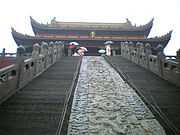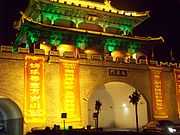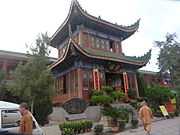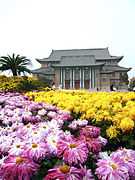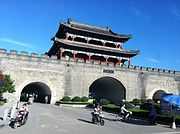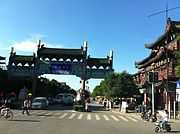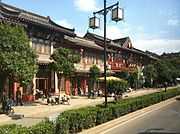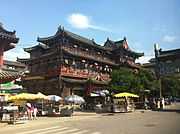Kaifeng
| Kaifeng 开封 | |||
|---|---|---|---|
| Prefecture-level city | |||
开封市 | |||
 | |||
| |||
 | |||
 Kaifeng | |||
| Coordinates: 34°48′N 114°18′E / 34.800°N 114.300°ECoordinates: 34°48′N 114°18′E / 34.800°N 114.300°E | |||
| Country | People's Republic of China | ||
| Province | Henan | ||
| Area | |||
| • Prefecture-level city | 6,247 km2 (2,412 sq mi) | ||
| • Urban | 546.4 km2 (211.0 sq mi) | ||
| • Metro | 546.4 km2 (211.0 sq mi) | ||
| Elevation | 75 m (245 ft) | ||
| Population (2010 census) | |||
| • Prefecture-level city | 4,676,159 | ||
| • Density | 750/km2 (1,900/sq mi) | ||
| • Urban | 826,961 | ||
| • Urban density | 1,500/km2 (3,900/sq mi) | ||
| • Metro | 826,961 | ||
| • Metro density | 1,500/km2 (3,900/sq mi) | ||
| Time zone | China Standard (UTC+8) | ||
| Area code(s) | 378 | ||
| GDP | ¥7,250 per capita (2004) | ||
| Major Nationalities | Han, Hui | ||
| County-level divisions | 5 | ||
| Township-level divisions | 5 | ||
| License plate prefixes | 豫B | ||
| Website | kaifeng.gov.cn | ||
Kaifeng (simplified Chinese: 开封; traditional Chinese: 開封; pinyin: Kāifēng; Wade–Giles: K'aifeng), known previously by several names (see below), is a prefecture-level city in east-central Henan province, People's Republic of China. It was the capital of the Northern Song Dynasty and once one of the greatest cities in the world.
There are currently nearly 5 million people living in its metropolitan area. Located along the southern bank of the Yellow River, it borders the provincial capital of Zhengzhou to the west, Xinxiang to the northwest, Shangqiu to the east, Zhoukou to the southeast, Xuchang to the southwest, and the province of Shandong to the northeast.
Names
The Chinese Postal Map Romanization for the city is "Kaifeng". Its official one-character abbreviation in Chinese is 汴 (Biàn). Historically it has also been known as:
- Dàliáng (Chinese: 大梁)
- Biànliáng (Chinese: 汴梁)
- Biànzhōu (Chinese: 汴州)
- Nánjīng (Chinese: 南京)
- Dōngjīng (Chinese: 東京)
- Biànjīng (Chinese: 汴京)
The name "Kaifeng" first appeared as the area's name after the Qin Dynasty's conquest of China in the 2nd century BC and literally means "expand the borders".[2]
Administration
The prefecture-level city of Kaifeng administers five districts and five counties.
- Gulou District (鼓楼区)
- Longting District (龙亭区)
- Yuwangtai District (禹王台区)
- Jinming District (金明区)
- Shunhe Hui District (顺河回族区)
- Weishi County (尉氏县)
- Qi County (杞县)
- Tongxu County (通许县)
- Lankao County (兰考县)
- Kaifeng County (开封县)
History
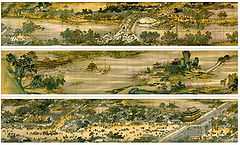
Kaifeng is one of the Eight Ancient Capitals of China. As with Beijing, there have been many reconstructions during its history.
In 364 BC during the Warring States period, the State of Wei founded a city called Daliang (大梁) as its capital in this area. During this period, the first of many canals in the area was constructed linking a local river to the Yellow River. When the State of Wei was conquered by the State of Qin, Kaifeng was destroyed and abandoned except for a mid-sized market town, which remained in place.
Early in the 7th century, Kaifeng was transformed into a major commercial hub when it was connected to the Grand Canal as well as through the construction of a canal running to western Shandong.
In 781 during the Tang Dynasty, a new city was reconstructed and named Bian (汴). Bian was the capital of the Later Jin (936–946), Later Han (947–950), and Later Zhou (951–960) of the Five Dynasties Period. The Song Dynasty made Bian its capital when it overthrew the Later Zhou in 960. Shortly afterwards the city underwent further expansion.
During the Song Dynasty when it was known as Dongjing or Bianjing, Kaifeng was the Chinese capital with a population of over 400,000, living both inside and outside the city wall. Typhus was an acute problem in the city. The historian Jacques Gernet provides a lively picture of life in this period in his Daily Life in China, on the Eve of the Mongol Invasion, 1250-1276, which draws on Dongjing Meng Hua Lu (Dreams of Splendor of the Eastern Capital), a nostalgic memoir.[3]
In 1049, the Youguosi Pagoda (佑國寺塔), or Iron Pagoda (铁塔) as it is called today was constructed measuring 54.7 metres (179 ft) in height. It has survived the vicissitudes of war and floods to become the oldest landmark in this ancient city. Another Song Dynasty pagoda, Bo Ta (繁塔), dating from 974 has been partially destroyed.
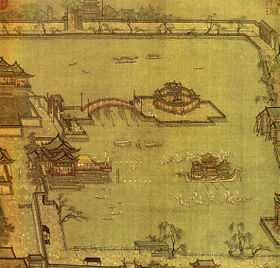
Another well-known sight was the astronomical clock tower of the engineer, scientist, and statesman Su Song (1020–1101 AD). It was crowned with a rotating armillary sphere that was hydraulically powered (i.e. by waterwheel and a clepsydra clock), yet it incorporated an escapement mechanism two hundred years before they were found in the clockworks of Europe and featured the first known endless power-transmitting chain drive.
Kaifeng reached its peak importance in the 11th century when it was a commercial and industrial center at the intersection of four major canals. During this time, the city was surrounded by three rings of city walls and probably had a population of between 600,000 and 700,000.
It is believed that Kaifeng was the largest city in the world from 1013 to 1127.[4]
This period ended in 1127 when the city fell to Jurchen invaders during the Jingkang Incident. It subsequently came under the rule of the Jurchen Jin Dynasty, which had conquered most of northern China in the Jin–Song wars.[5] While it remained an important administrative center, only the city area inside the inner city wall of the early Song Dynasty remained settled and the two outer rings were abandoned.
One major problem associated with Kaifeng as the imperial capital of the Song Dynasty was its location. While it was conveniently situated along the Grand Canal for logistic supply, Kaifeng was militarily vulnerable due to its position on the flood plains of the Yellow River.
Kaifeng served as the Jurchen "southern capital" from 1157 (other sources say 1161) and was reconstructed during this time.[6] The Jurchen kept their main capital further north until 1214 when they were forced to move the imperial court southwards to Kaifeng in order to flee from the Mongol onslaught. In 1232 they succumbed to the combined Mongol and Song Dynasty forces in the Mongol siege of Kaifeng. The Mongols captured the city, and in 1279 they conquered all of China.

At the beginning of the Ming Dynasty in 1368, Kaifeng was made the capital of Henan province.
In 1642, Kaifeng was flooded by the Ming army with water from the Yellow River to prevent the peasant rebel Li Zicheng from taking over. After this disaster the city was abandoned again.
In 1662, during the reign of the Kangxi Emperor in the Qing Dynasty, Kaifeng was rebuilt. However, further flooding occurred in 1841 followed by another reconstruction in 1843, which produced the contemporary Kaifeng as it stands today.
Kaifeng is also known for having the oldest extant Jewish community in China, the Kaifeng Jews.
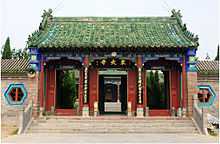
It is also a Muslim enclave, and contains what is thought to be China's oldest surviving mosque.[1]
In 1969, the former President of the People's Republic of China Liu Shaoqi, died from medical neglect while under house arrest in Kaifeng.
Climate
Kaifeng has a monsoon-influenced humid subtropical climate (Köppen Cwa) that borders on a humid continental climate, with four distinct seasons. Winters are cool and mostly dry while summers are hot and humid; spring is warm and sees some, but not much rainfall, while autumn weather is crisp and drier. Precipitation mainly occurs from June to September.
| Climate data for Kaifeng (1971−2000) | |||||||||||||
|---|---|---|---|---|---|---|---|---|---|---|---|---|---|
| Month | Jan | Feb | Mar | Apr | May | Jun | Jul | Aug | Sep | Oct | Nov | Dec | Year |
| Average high °C (°F) | 5.1 (41.2) |
8.4 (47.1) |
13.7 (56.7) |
21.5 (70.7) |
26.9 (80.4) |
31.3 (88.3) |
31.7 (89.1) |
30.5 (86.9) |
26.7 (80.1) |
21.3 (70.3) |
13.7 (56.7) |
7.3 (45.1) |
19.8 (67.7) |
| Average low °C (°F) | −4.1 (24.6) |
−1.7 (28.9) |
2.9 (37.2) |
9.6 (49.3) |
14.8 (58.6) |
19.8 (67.6) |
22.9 (73.2) |
22.0 (71.6) |
16.5 (61.7) |
10.1 (50.2) |
3.1 (37.6) |
−2.3 (27.9) |
9.5 (49.0) |
| Precipitation mm (inches) | 8.1 (0.319) |
11.2 (0.441) |
28.2 (1.11) |
35.4 (1.394) |
55.0 (2.165) |
73.4 (2.89) |
174.9 (6.886) |
109.7 (4.319) |
69.5 (2.736) |
41.5 (1.634) |
20.4 (0.803) |
9.9 (0.39) |
637.2 (25.087) |
| Avg. precipitation days (≥ 0.1 mm) | 2.9 | 3.9 | 5.9 | 6.2 | 6.8 | 7.8 | 11.3 | 9.0 | 7.6 | 6.6 | 4.5 | 3.0 | 75.5 |
| Source: Weather China | |||||||||||||
The best time of the year to visit Kaifeng is Spring (March to May) and Autumn (September to November), when the weather is warm and the chance of precipitation is low.
Transportation
Air
Downtown Kaifeng is about 55 km (34 mi) away from Zhengzhou Xinzheng International Airport – which has domestic connections to more than 20 cities, including Beijing Capital, Chengdu, Shanghai Hongqiao, Shanghai Pudong, Shenyang, Guangzhou, Shenzhen, Xiamen, Hangzhou, Fuzhou, Harbin etc. China Eastern and China Southern Airlines also provide some international connections directly from Zhengzhou.
Rail
Kaifeng Railway Station is on the East-West Longhai Railway mainline and provides convenient access to many cities around China, including Beijing West, Shanghai, Shanghai Hongqiao, Tianjin, Xi'an, Jinan, Hangzhou. Services to Zhengzhou, Luoyang and Qingdao are also frequent and convenient. Direct long distance services to Shenzhen, Guangzhou, Chengdu, Chongqing North, Harbin, Ürümqi, Fuzhou, Dalian and Wuhan are also available.
Coach
- There are 4 main coach stations in Kaifeng.
- Kaifeng West Coach Station (开封客运西站)
- Kaifeng Long Distance Coach Station (开封长途汽车站)
- Kaifeng Jinming Coach Station (开封金明汽车站)
- Kaifeng Xiangguosi Coach Station (开封相国寺汽车站)
There are frequent services to many neighbouring counties, other provincial cities and longer distance services to other provinces.
Light rail
The Zhengkai Intercity Railway (郑开城际铁路), also popularly known as the Zhengzhou Kaifeng Light Rail (郑开轻轨) project is well into its construction phase and due to start operation by 2013. The total length of the railway is 50.3 km (31.3 mi), connecting the provincial capital Zhengzhou and Kaifeng, with a projected future extension to a total of 57.4 km (35.7 mi). The initial phase of the project will have 5 stations in total constructed along the track, of which, 3 within the city boundary of Zhengzhou and 2 within the city boundary of Kaifeng. It is double tracked with a designed top speed capability of 200 km/h (120 mph). When the project finishes and operation starts, it is currently scheduled to provide an initial service frequency of about 4tph with projected increase according to actual demand. Total journey time is of not more than 30 minutes.
Road transport
Culture
Religion
Kaifeng is known for having the oldest extant Jewish community in China, the Kaifeng Jews. It also has a significant Muslim enclave and the oldest surviving mosque in China.
Cuisine
Kaifeng cuisine plays a dominant part in forming Henan cuisine.[7]
Kaifeng offers a wide range of food specialities such as steaming pie and dumplings. In the evening, Kaifeng's streets turn into restaurants while hundreds open their stands and begin selling their food in the famous night market. Often people from the nearby Zhengzhou come to Kaifeng to spend an evening with their family as the atmosphere is very appealing. Particularly famous is Kaifeng's five-spice bread (wǔxiāng shāobǐng), which, like pita, can be opened and filled.
Chrysanthemums
The chrysanthemum is the city flower of Kaifeng. The tradition of cultivating different varieties of chrysanthemums stretches all the way back 1600 years, and the scale reached a phenomenal level during the North Song Dynasty.
The city has held the Kaifeng Chrysanthemum Cultural Festival since 1983 (renamed China Kaifeng Chrysanthemum Cultural Festival from 1994). The festival has been a yearly feature since, taking place between 18 October and 18 November every year.
The festival reached another milestone in 2012, when it celebrated the 30th birthday.[8] The opening ceremony was broadcast live on Henan Satellite TV Channel (HNTV) at the evening prime slot on 18 October 2012, which has a coverage of all Chinese cities of or above the prefecture-level classification in the Chinese administrative division.
During the festival, chrysanthemums of hundred different types will not only be on show in all festival venues, but they become common features all around the city itself - Kaifeng truly becomes the "city of chrysanthemums".
Sporting Events
China Zheng-Kai International Marathon
China Zheng-Kai International Marathon is a sporting event hosted jointly by Chinese athletics association, the general sport administration of Henan province, Zhengzhou municipal government and Kaifeng municipal government. It’s the only major international sports competition in Henan province as well as one of the biggest major sports competition in the Central-West of China. ZK International Marathon is scheduled to be held at the end of March each year (8 April for 2012), the main part of the event is carried out along the famous Zhengkai Express Way (郑开大道). Starting from 2007, 5600 athletes entered the first edition, and until last year, almost 25000 athletes from 28 countries and regions have participated ZK international marathon and it has became more famous and matured in the world.
Military
Kaifeng is headquarters of the 20th Group Army of the People's Liberation Army, one of the three group armies that comprise the Jinan Military Region responsible for defence of the Yellow River Plain.
Kaifeng Airport is a military airfield in Southern suburb of Kaifeng City. It does not provide civilian aviation service.
Gallery
|
International relations
Twin towns — Sister cities
Kaifeng is twinned with:
| City | Region | Country |
|---|---|---|
| Wichita | |
|
| Kiryat Motzkin | |
|
| Toda | |
|
| Omsk | |
|
Colleges and universities
Public
- Henan University (河南大学) (founded 1912)
- Kaifeng University (开封大学) (founded 1980)
- Kaifeng Institute of Education (开封教育学院)
- Yellow River Conservancy Technical Institute (黄河水利职业技术学院) (founded 1929)
See also
- 1642 Kaifeng Flood
- Kaifeng Jews
- Kaifeng International Youth Hostel
Further reading
- Cotterell, Arthur. (2007). The Imperial Capitals of China – An Inside View of the Celestial Empire. London: Pimlico. pp. 304 pages. ISBN 978-1-84595-009-5.
- The Origin of the Kaifeng Jews, in S. Shaked, ed., Irano-Judaica, Jerusalem, 1982, pp. 101–11
References
- ↑ 1.0 1.1 NPR
- ↑ Zhongguo Gujin Diming Dacidian 中国古今地名大词典, 2005. (Shanghai: Shanghai Cishu Chubanshe), 348. (Chinese)
- ↑ Jacques Gernet. Daily Life in China, on the Eve of the Mongol Invasion, 1250-1276. (Stanford, CA: Stanford University Press, 1962). Translated by H. M. Wright. ISBN 0804707200.
- ↑ "Largest Cities Through History". Retrieved November 6, 2010.
- ↑ Lorge, Peter (2005). War, Politics and Society in Early Modern China, 900–1795. Routledge. pp. 52–54. ISBN 978-0-203-96929-8.
- ↑ "The Eastern Manchurian Woodsmen Replacing the Western Manchurian Nomads". Retrieved November 6, 2010.
- ↑ "豫菜成大器 任重而道远". Retrieved October 28, 2012.
- ↑ "China Kaifeng Chrysanthemum Cultural Festival". Retrieved October 28, 2012.
External links
| Wikimedia Commons has media related to Kaifeng. |
- Government website of Kaifeng (in Simplified Chinese)
- Kaifeng City Portal (in Simplified Chinese)
- About Kaifeng's Judaeo-Persian community
- China Kaifeng Chrysanthemum Cultural Festival - Travel Guide (in Simplified Chinese)
- The 30th Edition of the China Kaifeng Chrysanthemum Cultural Festival (in Simplified Chinese, Photos from xinhuanet.com)
- ZhengKai Marathon Official Site (in Simplified Chinese and English)
- Zhengkai Intercity Railway (in Simplified Chinese)
| Preceded by Chang'an |
Capital of China (as Kaifeng) 960−1127 |
Succeeded by Lin'an |
| ||||||||||||||||||||||||||
| |||||||||||||||||||||||||||||||||||||||||||||||||||||||||||||||
| ||||||||||||||||||||||||||||||||



